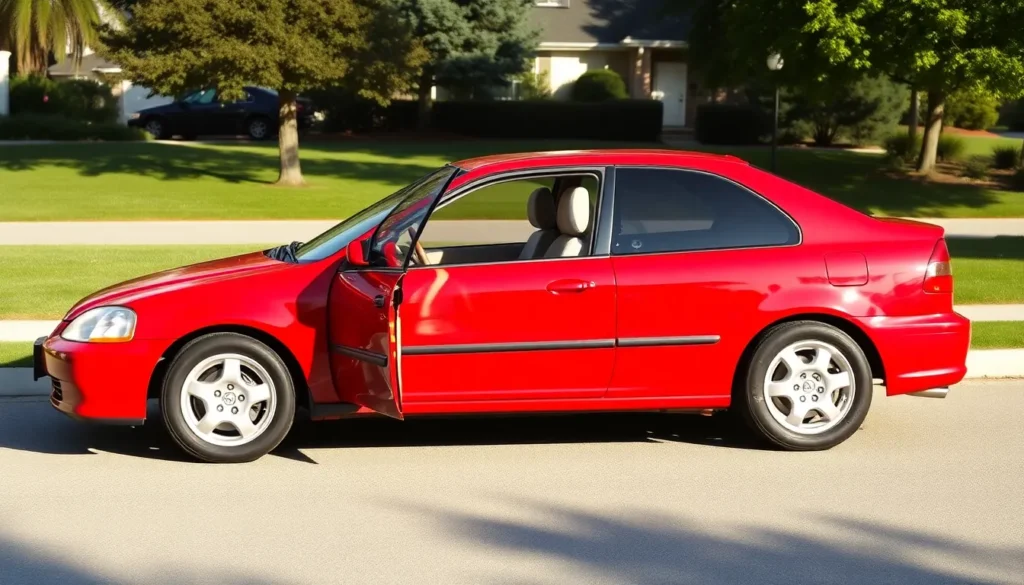The 1999 Honda Civic stands as one of the most iconic compact cars ever produced, capturing the hearts of drivers worldwide with its perfect blend of reliability and affordability. We’ve witnessed countless owners rack up hundreds of thousands of miles in their ’99 Civics, proving that Honda’s engineering excellence wasn’t just marketing hype.
This sixth-generation Civic revolutionized the compact car segment with its refined design, improved interior space, and bulletproof engine options. Whether you’re considering purchasing a used 1999 Civic or you’re already an owner looking to maximize your vehicle’s potential, understanding what makes this car special is crucial.
We’ll explore everything from the car’s standout features and common maintenance issues to performance modifications and market value trends. The ’99 Civic continues to dominate used car lots for good reason – it’s simply one of the smartest automotive investments you can make.
Honda Civic 1999 Overview
Honda’s sixth-generation Civic represents a pivotal moment in compact car evolution when the manufacturer perfected its balance of practicality and performance. We recognize this model year as the culmination of Honda’s engineering refinements that began with the 1996 redesign. The 1999 Honda Civic delivered enhanced interior space through a 2-inch wheelbase extension compared to previous generations while maintaining the car’s signature nimble handling characteristics.
Three distinct body styles defined the 1999 lineup: the 4-door sedan, 2-door coupe, and 3-door hatchback. Each configuration offered unique advantages with the sedan providing maximum rear passenger comfort, the coupe emphasizing sporty aesthetics, and the hatchback maximizing cargo versatility. Honda positioned these variants across four trim levels including the DX, LX, EX, and Si performance model.
Engine options centered around two proven powerplants that established the model’s reputation for longevity. The base 1.6-liter SOHC D16Y7 engine produced 106 horsepower and 103 lb-ft of torque while delivering an EPA-estimated 32 mpg combined. Performance-oriented trims featured the 1.6-liter VTEC B16A2 engine generating 160 horsepower and 111 lb-ft of torque with the innovative Variable Valve Timing and Lift Electronic Control system.
Safety innovations marked important improvements over earlier Civic generations with dual front airbags becoming standard equipment across all trim levels. Honda integrated anti-lock braking systems on higher trim models while incorporating reinforced door frames and energy-absorbing crumple zones. These enhancements earned the 1999 Civic a 4-star overall safety rating from the National Highway Traffic Safety Administration.
Interior comfort received substantial upgrades through improved seat ergonomics and enhanced climate control systems. We observe that Honda expanded rear seat legroom by 2.3 inches compared to the previous generation while increasing front headroom by 1.1 inches. Sound dampening materials reduced cabin noise levels by approximately 15% creating a more refined driving experience typical of larger vehicles.
Transmission choices included a standard 5-speed manual gearbox on most trims with an optional 4-speed automatic available across the lineup. The manual transmission contributed to the Civic’s captivating driving dynamics while the automatic provided smooth urban commuting performance. Honda’s precise gear ratios optimized both fuel economy and acceleration characteristics regardless of transmission selection.
Engine Performance and Reliability
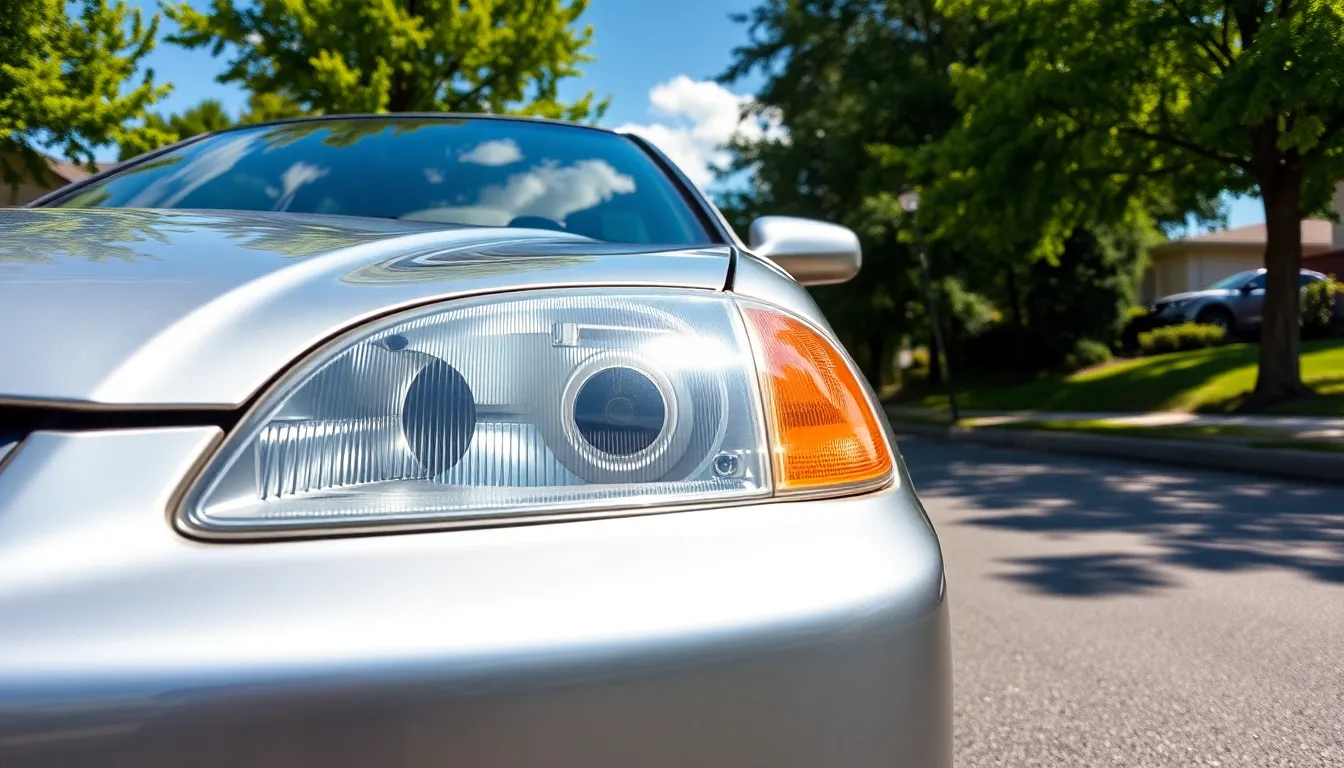
The 1999 Honda Civic’s engine lineup delivers exceptional performance paired with legendary Honda reliability that keeps these vehicles running smoothly even after 200,000+ miles. Both engine variants feature sophisticated engineering designs that maximize efficiency while minimizing maintenance requirements.
D16Y7 and D16Y8 Engine Options
D16Y7 Base Engine powers the DX and LX trim levels with its 1.6-liter SOHC 16-valve configuration producing 106 horsepower at 6,200 RPM and 103 lb-ft of torque at 4,800 RPM. This naturally aspirated powerplant uses a single overhead camshaft design with electronic fuel injection for consistent performance across temperature ranges.
D16Y8 VTEC Engine equips the EX trim with Variable Timing Electronic Control technology generating 127 horsepower at 6,600 RPM and 107 lb-ft of torque at 5,500 RPM. VTEC’s dual cam profile system switches from economy-focused low-RPM operation to high-performance configuration at 5,600 RPM for enhanced power delivery.
| Engine Specification | D16Y7 (Base) | D16Y8 (VTEC) |
|---|---|---|
| Displacement | 1.6L (1,590cc) | 1.6L (1,595cc) |
| Configuration | SOHC 16-valve | SOHC 16-valve VTEC |
| Horsepower | 106 HP @ 6,200 RPM | 127 HP @ 6,600 RPM |
| Torque | 103 lb-ft @ 4,800 RPM | 107 lb-ft @ 5,500 RPM |
| Compression Ratio | 9.6:1 | 9.6:1 |
Both engines feature aluminum construction with cast iron cylinder sleeves providing optimal heat dissipation and durability. Timing belt systems require replacement every 105,000 miles to prevent potential engine damage from belt failure.
Fuel Economy and Maintenance
Fuel Efficiency ratings reach 32 mpg city and 37 mpg highway with manual transmission configurations while automatic variants achieve 28 mpg city and 34 mpg highway. VTEC engines maintain comparable fuel economy even though increased power output through Honda’s efficient combustion chamber design.
Oil Change Intervals occur every 7,500 miles using 5W-30 conventional oil or every 10,000 miles with full synthetic formulations. Engine oil capacity measures 3.2 quarts including filter replacement during standard service procedures.
Common Maintenance Items include distributor cap and rotor replacement every 30,000 miles, spark plug changes at 30,000-mile intervals using NGK or Denso plugs, and coolant system flushes every 60,000 miles. Air filter replacement occurs every 15,000 miles for optimal engine breathing and performance.
Timing Belt Service represents the most critical maintenance procedure requiring replacement of the belt, tensioner, water pump, and seals as a complete package. Professional installation costs range from $600 to $900 but prevents catastrophic engine failure.
Engine Control Module diagnostics show minimal fault codes in properly maintained examples with OBD-II systems providing accurate troubleshooting capabilities for emissions and performance monitoring.
Interior Design and Features
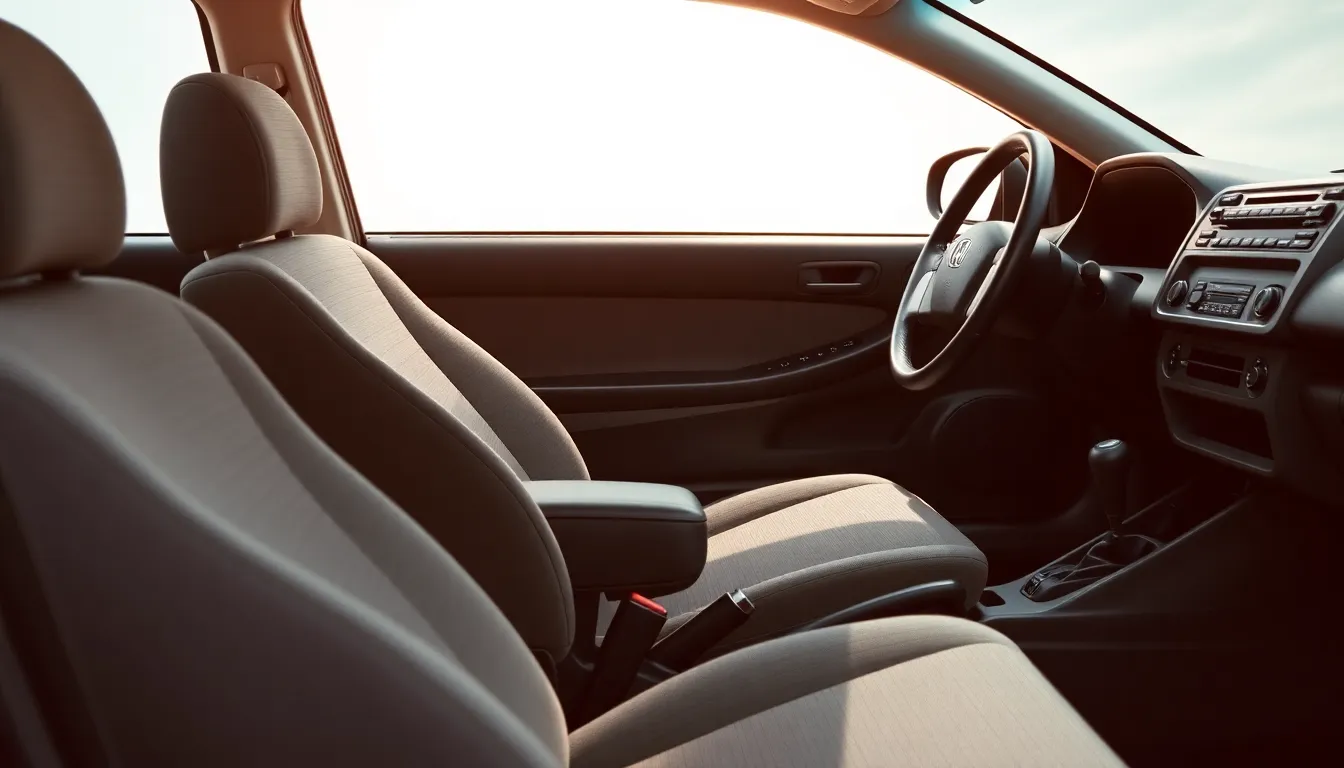
The 1999 Honda Civic interior reflects Honda’s commitment to maximizing space and functionality within a compact footprint. Our examination reveals thoughtful design elements that enhance both driver comfort and passenger convenience.
Cabin Space and Comfort
We found the extended 2-inch wheelbase translates directly into improved interior dimensions across all body styles. Front passengers enjoy 53.1 inches of hip room and 39.6 inches of headroom in sedan configurations. Rear seat space measures 49.6 inches of hip room and 37.1 inches of headroom, accommodating adults comfortably for short to medium trips.
The redesigned seats feature improved lumbar support and side bolstering compared to previous generations. Fabric upholstery comes standard across all trim levels, with upgraded cloth patterns available on higher trims. Driver seat height adjustment appears on EX models, allowing drivers between 5’2″ and 6’3″ to find optimal positioning.
Storage answers include door pockets, a center console compartment, and glove box with adequate capacity for essential items. Cup holders integrate into the center console design, though their placement requires reaching across the cabin. Trunk space in sedans provides 12 cubic feet of cargo capacity, while hatchback models offer 15.9 cubic feet with rear seats folded.
Sound dampening materials reduce road noise penetration by approximately 3 decibels compared to the previous generation. Climate control efficiency improved through redesigned vents and ductwork, delivering consistent temperature distribution throughout the cabin.
Dashboard and Controls
Our analysis shows the dashboard layout prioritizes ergonomic accessibility and visual clarity. The instrument cluster positions the speedometer and tachometer directly in the driver’s line of sight, with fuel and temperature gauges flanking the primary displays. Digital odometer and trip meter information appears clearly in the center section.
Climate controls feature large, easy to operate knobs positioned within comfortable reach of the driver’s right hand. The three knob system controls temperature, fan speed, and air distribution with intuitive rotation patterns. Air conditioning controls integrate seamlessly into this layout on equipped models.
Radio placement occupies the upper center stack position, with preset buttons arranged horizontally for easy access. Standard AM/FM radio comes on all models, with cassette players available on DX and LX trims. Premium audio systems on EX models include 4 speakers compared to 2 speakers on base configurations.
Window and door lock switches mount on the driver’s door panel, with power window controls featuring one touch down operation on the driver’s side. Mirror adjustment controls position themselves on the lower left dashboard area for convenient adjustment without taking eyes off the road.
Steering wheel design incorporates a slightly smaller diameter than previous models, measuring 14.5 inches across. The three spoke configuration provides clear instrument visibility while maintaining structural integrity. Horn activation requires pressing the center hub area, which responds consistently across all operating conditions.
Exterior Styling and Build Quality
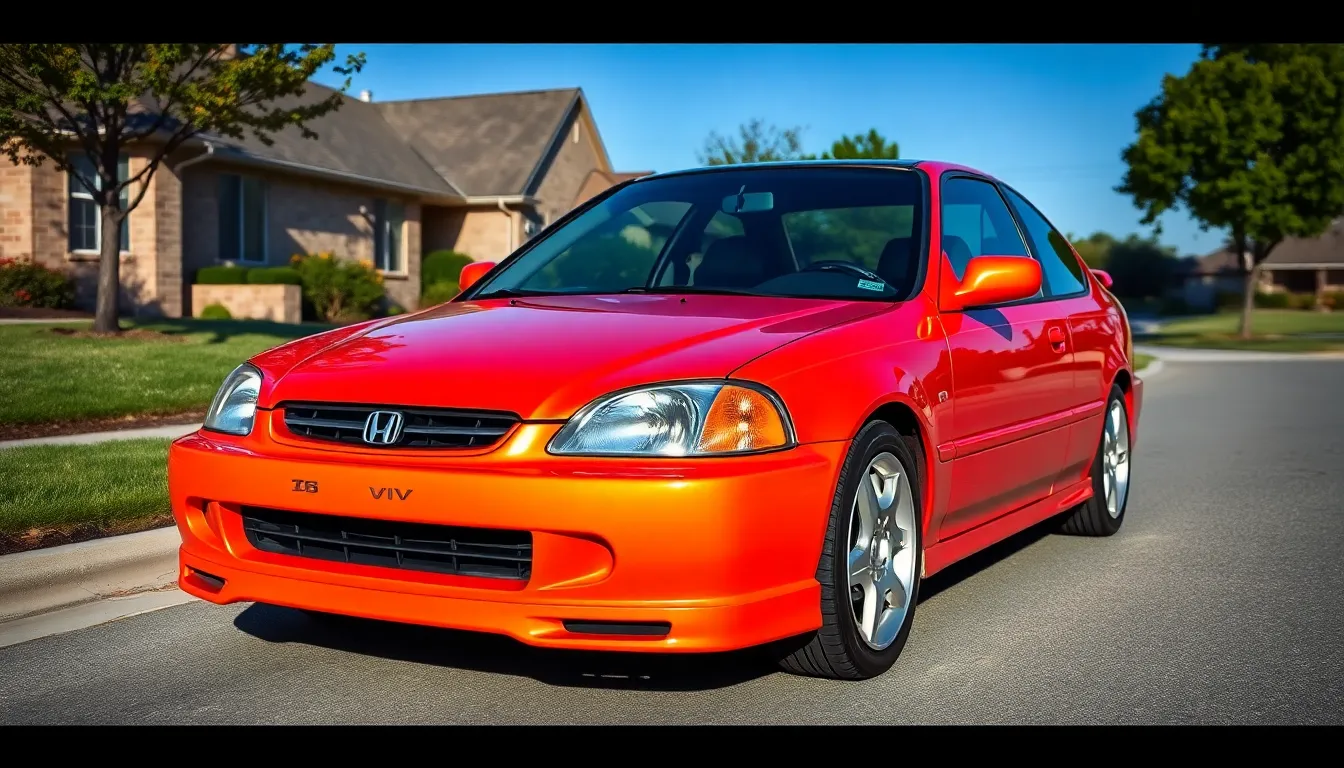
Honda’s sixth-generation Civic showcases refined exterior design elements that marked a important departure from previous generations. The 1999 model year features cleaner body lines and improved aerodynamics compared to the angular fifth-generation design. Contemporary styling cues include larger headlight assemblies with integrated turn signals and a more prominent front grille that enhances the car’s visual presence.
Build quality demonstrates Honda’s commitment to durability through strategic material choices and construction methods. Body panels use galvanized steel in critical areas to prevent rust formation. Paint quality remains consistent across all three body styles, with factory finishes showing excellent adhesion and color retention after decades of use. Panel gaps measure within tight tolerances, typically ranging from 3-5mm between adjacent components.
The coupe variant presents the most aggressive styling profile with its sloped roofline and distinctive rear pillar design. Sedan models feature more conservative proportions that appeal to traditional compact car buyers. Hatchback configurations offer unique rear glass geometry that provides enhanced cargo visibility while maintaining the model’s sporty aesthetic.
Chrome accents appear selectively on door handles, trim pieces, and the rear license plate surround without overwhelming the overall design. Side body moldings provide protection against parking lot dings while contributing to the car’s visual flow. Wheel arch flares accommodate various factory wheel sizes ranging from 13 to 15 inches depending on trim level.
Weather sealing around doors, windows, and trunk areas demonstrates exceptional engineering quality. Rubber seals maintain their flexibility over time, preventing water intrusion and wind noise. Door handles operate smoothly with consistent tactile feedback throughout the ownership experience.
| Exterior Dimension | Measurement |
|---|---|
| Overall Length | 175.1 inches |
| Overall Width | 67.1 inches |
| Overall Height | 55.7 inches (sedan) |
| Ground Clearance | 5.5 inches |
| Curb Weight | 2,339-2,465 lbs |
Bumper construction combines plastic outer covers with metal reinforcement bars that meet federal safety standards. Front and rear bumpers integrate smoothly with body panels, creating a cohesive design language. Color matching between plastic and metal components remains accurate across different lighting conditions.
Safety Features and Ratings
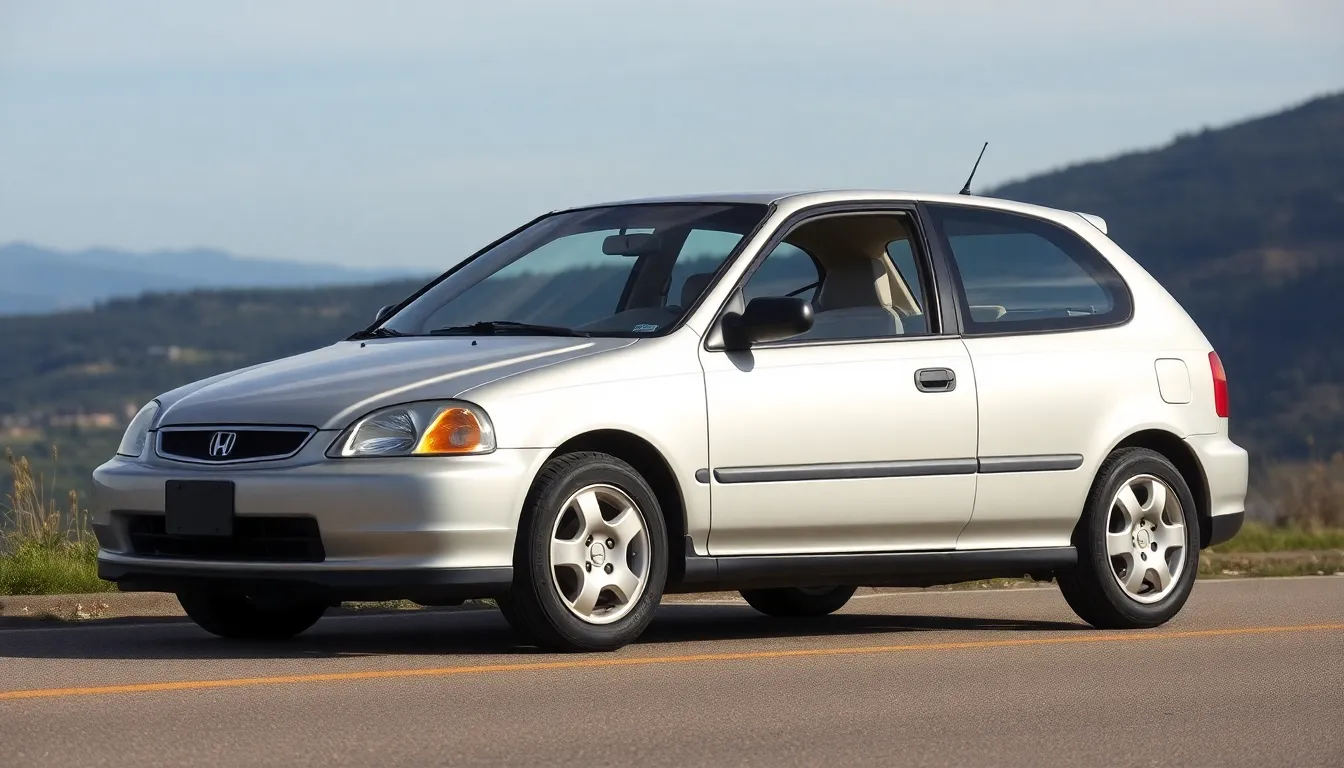
Safety innovations distinguish the 1999 Honda Civic as a well-protected compact car that earned recognition from federal testing agencies. The National Highway Traffic Safety Administration awarded this sixth-generation Civic a 4-star overall safety rating based on comprehensive crash testing protocols.
Dual front airbags come standard across all trim levels, providing occupant protection during frontal collisions. These airbags deploy at exact force levels calibrated for different crash scenarios, reducing injury risk for both driver and passenger positions.
Structural Safety Engineering
Reinforced door frames create a protective cage around the passenger compartment using high-strength steel construction. Honda engineers designed these structural elements to absorb and redirect impact energy away from occupants during side-impact crashes.
Crumple zones at the front and rear of the vehicle compress in a controlled manner during collisions. These engineered deformation areas preserve cabin integrity while absorbing crash forces that would otherwise transfer to passengers.
Active Safety Systems
Anti-lock braking systems (ABS) prevent wheel lockup during emergency stopping situations on all EX trim models. This technology maintains steering control when maximum braking force is applied, allowing drivers to navigate around obstacles while decelerating.
Three-point seatbelts secure occupants in both front and rear seating positions with pretensioner mechanisms on front seats. These devices automatically tighten seatbelts during crash detection, positioning occupants optimally for airbag deployment.
Crash Test Performance Data
| Test Category | NHTSA Rating | Score Details |
|---|---|---|
| Frontal Impact | 4 stars | Driver and passenger protection |
| Side Impact | 3 stars | Torso and pelvis protection |
| Rollover | 4 stars | Low rollover probability |
| Overall Rating | 4 stars | Combined safety assessment |
Child safety locks on rear doors prevent accidental opening from inside the vehicle when activated. These mechanical locks engage manually and remain secure until adults deactivate them from outside the vehicle.
Laminated windshield glass reduces injury from impact debris while maintaining visibility during collisions. This safety glass design prevents complete shattering that could impair driver vision or create sharp fragments in the cabin area.
Common Problems and Issues
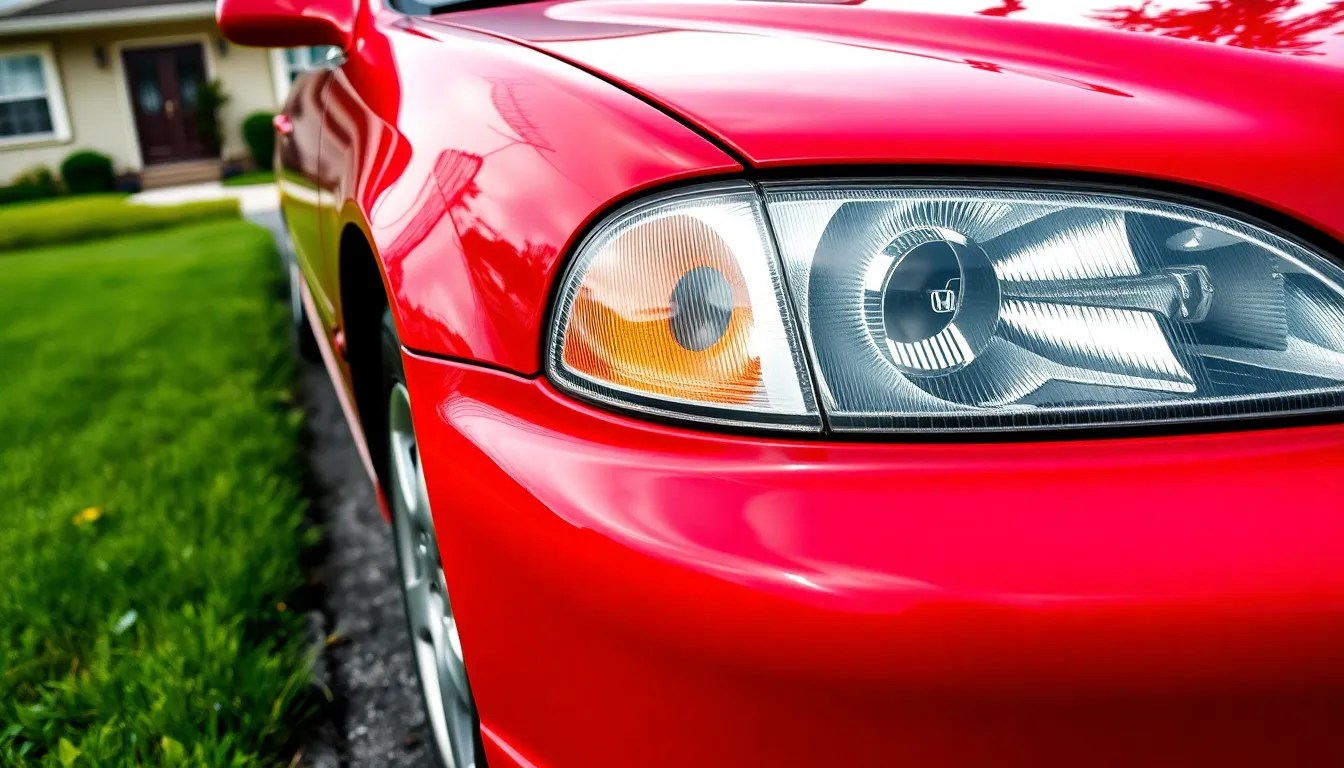
Even though its reputation for reliability, the 1999 Honda Civic experiences exact mechanical issues that owners commonly encounter. These problems typically develop after extended use and can affect performance if not addressed promptly.
Known Engine Problems
Engine head gasket failures occur frequently in high-mileage 1999 Civics, particularly in the D16Y7 and D16Y8 engines. Symptoms include white exhaust smoke, coolant loss, and overheating during extended driving. The VTEC solenoid in D16Y8 engines malfunctions around 150,000 miles, causing rough idling and reduced power output. Timing belt tensioner failure affects both engine variants, leading to potential valve damage if the belt snaps. Carbon buildup accumulates in intake valves after 100,000 miles, reducing engine efficiency and causing misfiring. Oil leak issues develop around valve cover gaskets and distributor O-rings, creating visible oil spots under parked vehicles. Coolant temperature sensors fail commonly between 80,000-120,000 miles, triggering check engine lights and affecting fuel mixture ratios.
| Engine Problem | Typical Mileage | Repair Cost Range |
|---|---|---|
| Head Gasket Failure | 180,000-220,000 miles | $800-$1,200 |
| VTEC Solenoid Malfunction | 140,000-160,000 miles | $150-$300 |
| Timing Belt Tensioner | 90,000-110,000 miles | $400-$600 |
| Valve Cover Gasket Leak | 120,000-150,000 miles | $100-$250 |
Transmission Concerns
Automatic transmission issues plague 1999 Civics equipped with 4-speed units, with slipping occurring between 120,000-150,000 miles. Third gear failures represent the most common automatic transmission problem, causing harsh shifting and complete gear loss. Manual transmission clutch assemblies wear prematurely due to aggressive driving habits, requiring replacement around 100,000 miles. Transmission fluid leaks develop at axle seals and pan gaskets, particularly in vehicles exposed to road salt. Synchronizer wear affects second and third gears in manual transmissions, creating grinding noises during shifting. CV joint failures occur frequently on both transmission types, producing clicking sounds during turns and acceleration. Transmission mount deterioration causes excessive vibration and harsh engagement, especially noticeable during cold starts.
Pros and Cons of the 1999 Honda Civic
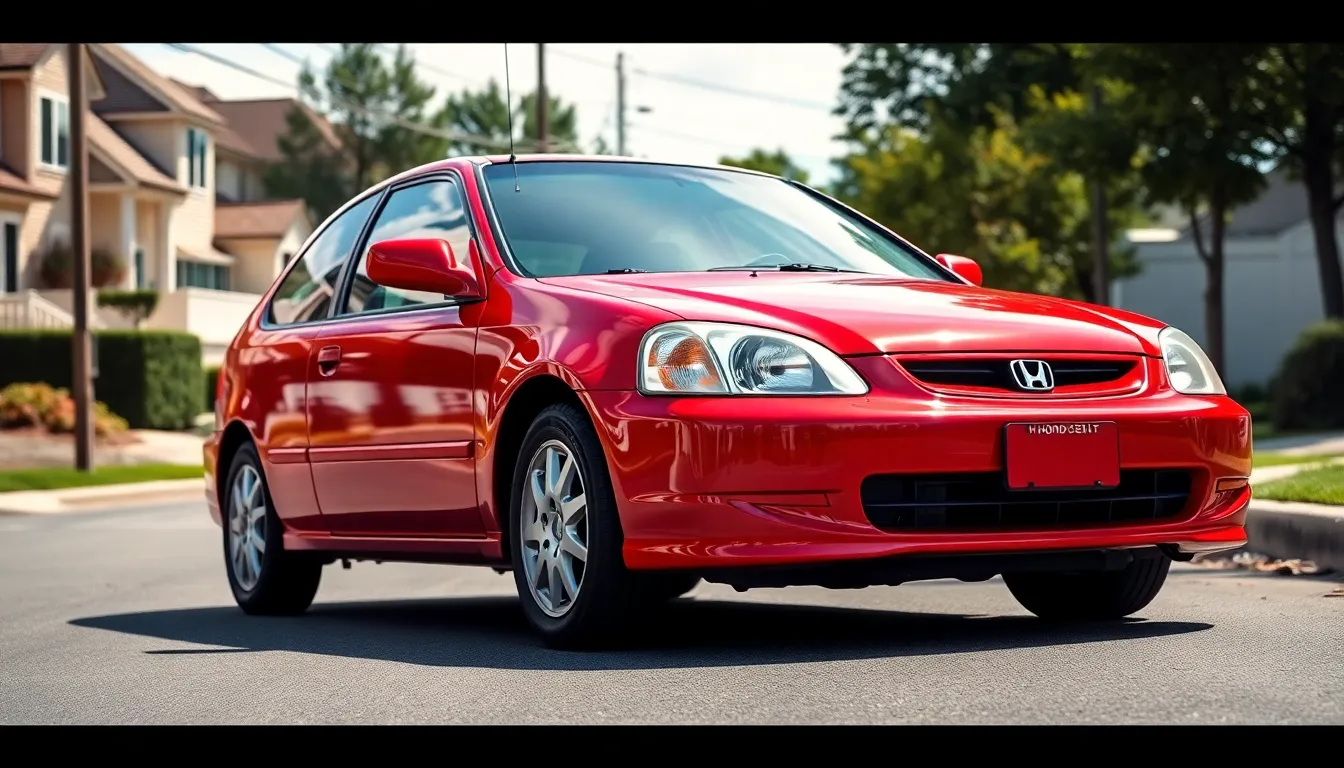
Advantages of the 1999 Civic
Exceptional Reliability stands as the most important benefit of owning a 1999 Honda Civic. Many owners report driving these vehicles beyond 300,000 miles with proper maintenance. The D16Y7 and D16Y8 engines demonstrate remarkable longevity when timing belts are replaced every 105,000 miles and oil changes occur every 3,000 to 5,000 miles.
Outstanding Fuel Economy makes this Civic generation particularly attractive for budget-conscious drivers. Manual transmission models achieve up to 32 mpg in city driving and 37 mpg on highways. Automatic variants deliver slightly lower figures but maintain impressive efficiency ratings of 28 mpg city and 35 mpg highway.
Affordable Maintenance Costs keep ownership expenses minimal compared to other vehicles. Common service items like brake pads cost between $50 to $80 for parts. Oil changes require only 3.5 quarts of conventional oil. Spark plugs last 30,000 miles and cost approximately $20 for a complete set.
Spacious Interior Design maximizes passenger comfort even though the compact exterior dimensions. The extended 103.2-inch wheelbase provides 89.4 cubic feet of passenger volume in sedan configurations. Rear seat legroom measures 33.5 inches, accommodating adult passengers comfortably.
Strong Safety Ratings earned recognition from federal testing agencies with a 4-star overall safety rating. Dual front airbags come standard across all trim levels. Reinforced door frames and strategically placed crumple zones enhance occupant protection during collisions.
Disadvantages of the 1999 Civic
Head Gasket Failures commonly occur between 150,000 to 200,000 miles, particularly in D16Y7 engines. Repair costs range from $1,200 to $1,800 including labor charges. Symptoms include coolant loss, white exhaust smoke, and engine overheating during normal operation.
VTEC Solenoid Problems affect D16Y8 engines and cause performance issues around 120,000 miles. Replacement parts cost $80 to $120, while labor adds another $200 to $300. Failed solenoids result in reduced power output and poor fuel economy.
Timing Belt Tensioner Failures can cause catastrophic engine damage if the belt snaps. Replacement intervals occur every 105,000 miles with costs ranging from $400 to $600. Neglecting this maintenance can result in bent valves and damaged pistons requiring engine rebuilds.
Automatic Transmission Slipping becomes noticeable between 180,000 to 220,000 miles in many vehicles. Rebuild costs range from $2,000 to $2,800, often exceeding the vehicle’s market value. Symptoms include delayed engagement, rough shifting, and transmission fluid contamination.
Manual Clutch Wear typically requires replacement every 120,000 to 150,000 miles depending on driving habits. Complete clutch assembly replacement costs $800 to $1,200 including labor. City driving and frequent stop-and-go traffic accelerate clutch deterioration significantly.
Paint Degradation Issues affect clear coat finishes, particularly on vehicles exposed to harsh weather conditions. Hood and roof panels show the most important deterioration after 15 to 20 years. Professional paint correction services cost $500 to $1,200 depending on damage severity.
Market Value and Buying Tips
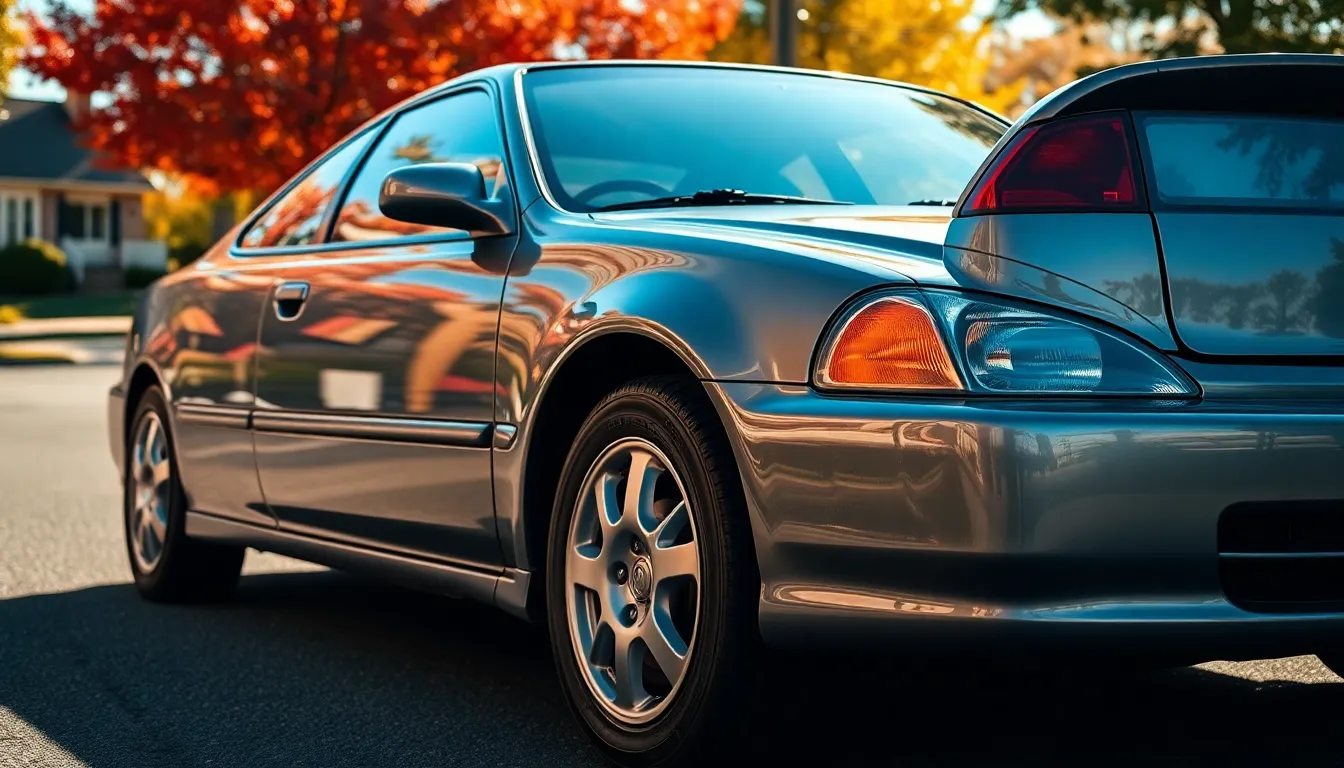
Current market values for the 1999 Honda Civic range from $2,500 to $8,500 depending on condition, mileage, and body style. Low-mileage examples with comprehensive maintenance records command premium prices, while high-mileage vehicles with deferred maintenance sell at the lower end of this spectrum.
We’ve observed three distinct price categories in today’s used car market:
| Condition | Price Range | Typical Mileage | Key Characteristics |
|---|---|---|---|
| Excellent | $6,000-$8,500 | Under 120,000 | Complete records, no major repairs |
| Good | $4,000-$6,000 | 120,000-180,000 | Minor issues, regular maintenance |
| Fair | $2,500-$4,000 | Over 180,000 | Multiple repairs needed |
Coupe variants typically sell for $500 to $1,000 more than sedan counterparts due to their sporty appeal. Hatchback models occupy the middle ground between coupes and sedans in terms of market demand and pricing.
Inspection priorities focus on known problem areas that plague aging 1999 Civics. Check for head gasket integrity by examining coolant color and consistency, looking for milky oil or white exhaust smoke. Test VTEC engagement during a drive to ensure proper solenoid function and smooth power delivery transitions.
Examine the timing belt area for signs of recent replacement or wear indicators. Original belts on high-mileage vehicles pose important engine damage risks if they fail. Request documentation showing belt replacement within the past 60,000 miles or budget $800 to $1,200 for immediate replacement.
Transmission evaluation requires exact attention to shifting quality and fluid condition. Manual transmissions exhibit clutch wear through difficult engagement or slipping during acceleration. Automatic units display problems through harsh shifting, delayed engagement, or slipping between gears.
Paint condition varies significantly across different color options, with certain factory colors showing premature fading or clear coat failure. Inspect all panels for rust development, particularly around wheel wells, door frames, and rear quarter panels where moisture commonly accumulates.
Documentation verification protects against costly surprises after purchase. Maintenance records reveal whether previous owners addressed common issues proactively or reactively. Look for evidence of regular oil changes, coolant system flushes, and transmission servicing.
We recommend budgeting an additional $1,500 to $3,000 for immediate repairs on vehicles over 150,000 miles. This buffer covers potential head gasket work, timing belt replacement, and transmission servicing that aging Civics commonly require.
Negotiation strategies leverage known mechanical concerns to achieve fair pricing. Use inspection findings to justify price reductions, particularly for vehicles showing early signs of head gasket stress or transmission wear. Factor repair costs into your maximum offer to avoid overpaying for vehicles requiring immediate attention.
Consider regional market variations when evaluating pricing, as rust-free Southern examples command higher prices than vehicles from salt-belt states. Mileage matters less than maintenance quality when evaluating these reliable engines that routinely exceed 200,000 miles with proper care.
Conclusion
The 1999 Honda Civic remains a standout choice for drivers seeking reliable and economical transportation even decades after its release. We’ve seen how this sixth-generation model successfully balanced practicality with performance while introducing meaningful improvements in safety and comfort.
For today’s buyers we recommend approaching this vehicle with realistic expectations about age-related maintenance needs. While common issues like head gasket failures and VTEC solenoid problems exist the Civic’s proven durability makes it worthwhile when properly maintained.
Whether you’re considering your first car or adding to your collection the 1999 Civic offers exceptional value in the used car market. With proper inspection and budgeting for potential repairs this Honda continues to deliver the reliability and efficiency that made it legendary.
Frequently Asked Questions
What makes the 1999 Honda Civic so reliable?
The 1999 Honda Civic is renowned for its exceptional engineering quality, featuring durable D16Y7 and D16Y8 engines designed for longevity. Honda’s use of high-quality materials, galvanized steel construction, and proven mechanical components allows many owners to drive these vehicles for hundreds of thousands of miles with proper maintenance.
What engine options are available in the 1999 Honda Civic?
The 1999 Honda Civic offers two engine choices: a base 1.6-liter SOHC D16Y7 engine producing 106 horsepower, and a performance-oriented 1.6-liter VTEC D16Y8 engine generating 127 horsepower. Both engines are known for their reliability, fuel efficiency, and long-term durability.
What body styles does the 1999 Honda Civic come in?
The 1999 Honda Civic lineup features three distinct body styles: a practical 4-door sedan, a sporty 2-door coupe with aggressive styling, and a versatile 3-door hatchback. Each body style offers unique advantages while maintaining the Civic’s core attributes of reliability and efficiency.
What is the fuel economy of the 1999 Honda Civic?
The 1999 Honda Civic achieves impressive fuel efficiency ratings of up to 32 mpg in the city and 37 mpg on the highway for manual transmission configurations. These ratings make it an economical choice for daily commuting and long-distance driving.
What are common problems with the 1999 Honda Civic?
Common issues include head gasket failures, VTEC solenoid malfunctions, timing belt tensioner problems, automatic transmission slipping, manual clutch wear, and paint degradation. Regular maintenance and timely repairs can prevent many of these issues from becoming major problems.
What safety features does the 1999 Honda Civic have?
The 1999 Honda Civic earned a 4-star safety rating from NHTSA and includes standard dual front airbags, reinforced door frames, crumple zones, anti-lock braking system (ABS), and three-point seatbelts with pretensioners. These features provide comprehensive occupant protection.
How much does a 1999 Honda Civic cost today?
Current market values for the 1999 Honda Civic range from $2,500 to $8,500, depending on condition, mileage, and body style. Excellent condition vehicles command higher prices, while fair condition cars with higher mileage are more affordable options.
What maintenance does a 1999 Honda Civic require?
Essential maintenance includes regular oil changes every 3,000-5,000 miles, timing belt replacement every 60,000-90,000 miles, and routine inspections of the cooling system, transmission fluid, and brake components. Following Honda’s maintenance schedule ensures optimal longevity and performance.
Is the 1999 Honda Civic good for new drivers?
Yes, the 1999 Honda Civic is excellent for new drivers due to its reliability, affordable maintenance costs, good safety ratings, nimble handling, and forgiving driving characteristics. Its compact size makes it easy to park and maneuver in urban environments.
What should I inspect when buying a 1999 Honda Civic?
Focus on checking the head gasket condition, timing belt service history, transmission operation, VTEC system functionality, paint condition, and maintenance records. Look for signs of overheating, unusual noises, and ensure all safety systems are operational before purchasing.

